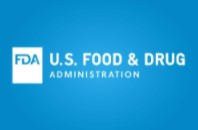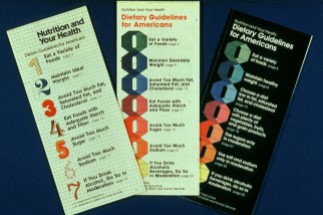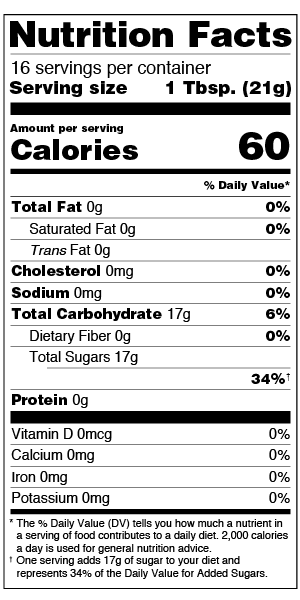Have you ever wondered about those nutrition labels plastered on all your favorite food items?

In this three-part series, we dive deep into nutrition charts. Part 1 covers the history of nutrition labels, while Part 2 helps readers understand the nutrients listed. Lastly, in Part 3, we discuss whether or not you can trust them. After all, knowledge is power. If you want to know about nutrition and how your body responds, this blog on nutrition labels will help you understand what you put in your body and what you get out of every grocery run.
To start this three-part blog, here’s a history lesson on how nutrition charts came to be.
Part 1 | History of the Nutrition Facts Label
The beginning of dietary labeling dates back to the age of Lincoln. In 1862, President Lincoln launched the Department of Agriculture and the Bureau of Chemistry, the predecessor of the Food and Drug Administration.
Food and Drugs Act

In 1906, after nearly 25 years of petitioning by chemists within the Department of Agriculture, the original Food and Drugs Act is passed by Congress. It prohibited interstate commerce of contaminated foods, drinks, and drugs. Additional legislation passed in the following years to require food manufacturers to disclose additives and establish the safety of ingredients. It took 60 years from the original Food and Drugs Act for the Fair Packaging and Labeling Act to pass. As the name implies, it requires all consumer products in interstate commerce to be honestly and informatively labeled, including food.

Dietary Guidelines for Americans
In 1980, the U.S. Department of Agriculture and Department of Health and Human Services published the Dietary Guidelines for Americans for the first time. These recommendations are updated every 5 years and are meant to be the Nation’s go-to source for nutrition advice. Despite the goal of helping Americans make healthy food and beverage choices by making dietary recommendations, it quickly became apparent in the 1980s that without clearer nutrition labeling it was too difficult for individuals to try to adhere to the guidelines. Different products mentioned different nutrients, making side-by-side comparisons nearly impossible.
Nutrition Labeling and Education ACT (NLEA)
In the age of such atrocities as Crystal Pepsi (it’s back in select stores, apparently) and oversized plaid shirts and overalls (wait… those have made a come back too?), we got the first official rendition of the nutrition facts label. In 1990, the Nutrition Labeling and Education Act (NLEA) was passed by congress. NLEA gave the FDA authority to require nutrition labeling on most food packages and specified the nutrients to be listed on the label. NLEA also required that nutrients be presented in the context of the daily diet.
Law Creates Label
This law created the nutrition label as we now know it, requiring the following nutrients to be included: calories, calories from fat, total fat, saturated fat, cholesterol, sodium, total carbohydrate, dietary fiber, sugars, protein, vitamins A and C, calcium, and iron. Additional nutrients, like trans fat, were added later.
So there you have it: the history of nutrition charts and labels. Now it's time to break down the nutrients discussed.
Part 2 | Nutrient Breakdown
 Picture this: you’re on a cheesy game show steps away from winning an enormous amount of money. The final question posed to you: “What do all the food items in the inner aisles of a grocery store have in common that raw fruits and vegetables don’t?” Did you answer, “They all have their nutrition facts listed on them”?
Picture this: you’re on a cheesy game show steps away from winning an enormous amount of money. The final question posed to you: “What do all the food items in the inner aisles of a grocery store have in common that raw fruits and vegetables don’t?” Did you answer, “They all have their nutrition facts listed on them”?
If so, then… DING, DING, DING! We have a winner.
The iconic chart on all processed food items holds a wealth of information about the nutritional value behind what you’re consuming. Whether you’re looking for the serving size for meal planning, calorie counts for weight management, or macronutrient breakdowns for post-workout recovery benefits, the nutrition label is an important tool that can help you maintain a healthy lifestyle. There’s only one problem. These charts are often confusing to the average American, making it more difficult to stay on the path to health and wellness.

Anatomy of nutrition facts:
Serving Size
The appearance of every nutrition label is the same thanks to the handy standardization of the NLEA. At the top, you’ll find recommended serving size (based on nutritional recommendations, not how many Oreos you plan to eat). Keep in mind that everything else on the label will give you metrics based on that serving size. So, if you eat more or less than the serving size, the nutrient totals will change.
Calories
Below serving size, you’ll find the number of calories in that portion. Calories are a unit of heat energy that our body processes as fuel. The more active you are, the more calories you generally need to fuel those activities. Post-workout treats aren’t just satisfying emotionally – they are important from an energy perspective too! Find some awesome post-workout snacks that Genesis Health Clubs experts recommend.
Fat
Fat metrics are listed next. Total fat, listed in grams, tabulates the amount of dietary fat in the food or beverage. While saturated and trans fat totals are listed below total fat, those aren’t the only types of dietary fat you’re consuming (just the only potentially harmful ones). Total fat includes healthy monounsaturated fatty acids, polyunsaturated fatty acids, and omega-3 fatty acids (those things that you hear doctors rave about). For best practices on keeping saturated fat low and trans fat non-existent, see here.
Cholesterol
Cholesterol follows fat on the label. Dietary cholesterol is different than blood cholesterol, and many nutrition scientists argue that it doesn’t need to be on the nutrition label anymore. There isn’t a risk for overconsumption of dietary cholesterol, so don’t spend time worrying about this line item on the chart.
Sodium
Good ol’ NaCl – or sodium – is next on the list. Salt is often added to processed food to help extend the shelf life of an item, so the bag of Lay’s you’re munching on at the office is going to report much higher sodium than a cup of yogurt or fruit. The USDA dietary guidelines recommend keeping total sodium consumption at or below 2,300 mg/day.
Carbohydrates, Fiber, and Sugar
We can’t think about carbs without thinking about how much Oprah loves bread, but there’s more to carbohydrates than baked goods. Carbohydrates are broken down into sugars, sugar alcohols, starches, and dietary fiber. Don’t let sugars get a bad rep, though. Currently, the nutrition label doesn’t differentiate between naturally occurring sugars, like those found in fruit or milk, and added sugars. Dietary fiber is also technically sugar. Fiber is made up of sugar molecules linked together, just in a way that is not readily digested.
Protein
Next on the label is a bodybuilder's favorite macronutrient: protein. Protein helps your body build and repair cells and body tissue, making it an important component of post-workout snacks or meals. Protein is also a major part of your skin, hair, nails, muscle, bone, and internal organs… so basically, you need protein to function and be healthy daily. Vitamins and Minerals
Vitamins and Minerals
You'll see vitamins and minerals listed near the bottom of the nutrition chart, but only as a percent daily value based on a 2,000-calorie-a-day diet. In general, anything above 20% is “high” for that vitamin. Anything under 5% is “low” in that vitamin. Break out the mental calculator and make sure you reach 100% in these vitamins and minerals by the end of the day.
You now have a basic breakdown of the nutrients listed on nutrition labels. So let's discuss whether or not you can trust them!

Part 3 | Can You Trust Nutrition Labels?
The time has come to answer an important question… Can you trust those nutrition charts?
Unfortunately, nutrition labels aren’t as transparent as we – the consumers – might hope.
Margin Of Error
The law allows a margin of error of up to 20 percent for the stated value versus the actual value of nutrition. Those handy “100 calories” portioned snacks could have up to 120 calories without violating the law. Beyond calorie-counters, this can have a serious impact on diabetic carb counters or people with high blood pressure who have to monitor sodium.
The FDA doesn’t have a systematic auditing process set up, and food manufacturers are expected to self-enforce the law.
Does that mean you should ignore nutrition labels altogether?
No! Studies have shown that the awareness of a food’s approximate nutritional content and portion size influences eating behaviors in a beneficial way. So while you may be consuming 20 more calories than you’re intending by grabbing that pre-portioned snack, it can help you balance healthy eating choices with a busy lifestyle.
Don’t be fooled by Packaging and Marketing.
Brands use packaging to try to get you to purchase their product over their competitors, using phrases like "natural" to sell their product. You also might notice a flux of brands tweaking their packaging to feature nutrition “highlights” more prominently. Whether that is Kellogg’s blasting “whole grains” or “natural” being added to hotdog packaging to call out their “unnatural” competitors, it’s important to consider the marketing strategy that went into the packaging decision.
Natural and Organic, FDA Approved
The FDA considers “natural” food not to contain artificial ingredients or preservatives and be only minimally processed. This says nothing about containing GMOs, hydrogenated vegetable oils, antibiotics, or growth hormones. Currently, organic is the only seal that is legitimately recognized and monitored by the USDA. Last fall, the FDA asked the public their thoughts on what constitutes as “natural,” so fingers crossed that clarification is coming. By keeping your focus on the nutrition facts on the back of the package and the ingredient list, you’ll be able to avoid any gimmicks trying to sway your opinion about the nutritional superiority of the food.
When it comes to nutrition labels, the bottom line is...
1. Pay close attention to nutrition labels and understand the nutrients and their amounts listed.
2. Be aware of marketing strategies and don't fall for them!
3. Use nutrition labels as a guide and ONLY as a guide.
Knowing the facts and being aware of all the health information and misinformation out there can help you achieve your fitness goals! At Genesis Health Clubs, we want you to feel confident about what you put in your body. We want you to feel encouraged, not discouraged when buying food fit for optimal health,
We hope this series on nutrition labels helps you on your health and wellness journey as you come to understand nutrition and what your body needs to succeed.




